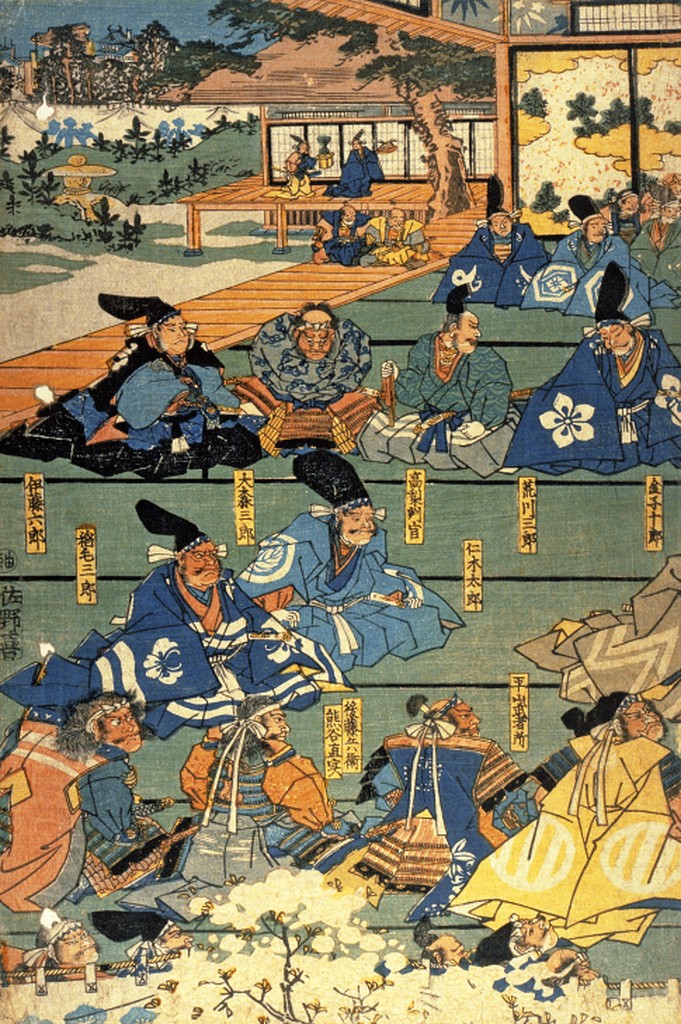
Title: Triptych
Creator: Utagawa Kunisada
Period: Edo
Date: 1840
Culture: Japan
Series: N/A
Style: Ukiyo-e
Medium: woodblock print; ink and color on paper
Dimensions: 34 x 23 cm
Repository: Wetmore Print Collection, Art History Dept., Cummings Arts Center, Connecticut College, New London
Credit line: Gift of Prof. Caroline Black, Botany Dept., Connecticut College
ID number: slide# 0002; black096
Additional Notes: This print is a part of a series of three known as a triptych. Although the title is still not fully known, the Japanese texts speak of an army assessment of some kind. The general of the army has been identified as Yoshimoto, but no further questions have been answered. As for the architectural aspects of the print, the buildings don’t have strict foundations and are elevated from the ground. This would allow the structure to be more earthquake resistant.
Description
This print is the left panel of a triptych bearing the title of “左馬頭義朝軍評定之圖,” which means the “assessment” of Yoshitomo’s army. The head of the army (not shown here) has been identified as Minamoto no Yoshitomo (1123-1160), a general who rose in power in the late Heian period.
The building in this print does not have a solid foundation but is elevated from the ground. This would allow the structure to withstand earthquakes and high humidity. Wood is used as the principal building material to ensure maximum absorption of the seismic energy released in an earthquake. Instead of walls, the room is enclosed by movable screens (shoji) and sliding doors (fusuma). The screens and doors are made out of traditional Japanese paper, and the screens allow natural light to pass through into the interior space. Through this use of light, the two spaces blend together suggesting a strong connection between nature and architecture. The spaces can also change from interior to exterior as the screens can be easily rearranged at any given moment.
The characters in the print are seated in a cross-legged or kneeling position, facing toward the viewer’s right, where Yoshitomo is seated. Each figure has his name written on the yellow vertical cartouche next to the portrait. They are sitting on tatami mats made from rice straw. The interior of the building looks very bland as it lacks any additional furniture other than the tatami mats and the painted fusuma, which appear rather simple and provide only the basic necessities of dwelling. An open floor plan makes up the space, which allows the spaces to blend together without the obstruction of walls. The cherry blossom trees covering the bottom border of the print could represent mortality. After their two week bloom, death follows for the flower, such as the lives of the soldiers. Life can be cut short at any given time, so it is important to cherish every moment. The rock garden also ties in with mortality and ephemerality as the pattern in the sand only exists briefly.
References
Kunisada, Japanese. Triptych. color woodcut. Place: Wetmore Print Collection, Art History Dept, Cummings Arts Center, Connecticut College, New London, Donated by Prof. Caroline Black, Botany Dept, Connecticut College. https://library.artstor.org/asset/CONNASIAN_106310758469 (access to Artstor required).
Aucfan. “Genuine Ukiyo-e 3 Pieces in a Row Left Horse Head Yoshitomo Army Rating Nozomi Utagawa Toyokuni Painting! .” Aucfan, aucview.aucfan.com/yahoo/j454590085/.
“Japanese Triptych Print by Kunisada (1786-1865) – Japan – circa 1840.” Catawiki, www.catawiki.com/l/9549671-japanese-triptych-print-by-kunisada-1786-1865-japan-circa-1840.